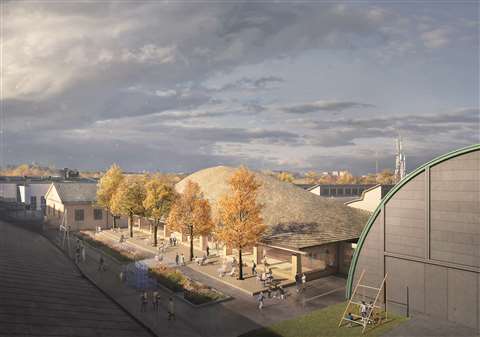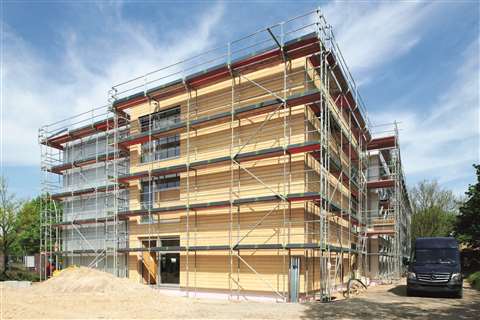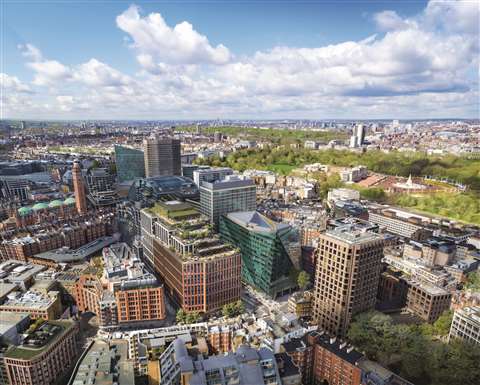Sustainable construction materials
12 April 2022
With the eyes of the world increasingly looking at how sustainable construction is, the use of ‘greener’ materials could make a real difference, writes Andy Brown.
Sustainability is the biggest trend in the construction industry – it is the biggest trend in the world. As more focus is placed on climate change and rising emissions, the spotlight is, understandably, increasingly being shone on construction; the industry is one of the world’s largest producers of greenhouse gas.

The sector is looking to address this in a number of ways, such as making the diesel engines that power the vast majority of equipment produce less pollutants than ever (or changing diesel altogether for electric) and ensuring that the materials used in projects across the world are more sustainable than ever before. But how do we define sustainable construction materials?
“Unfortunately, there is not a single definition for a sustainable construction material, which means everyone can understand it differently,” says Veronika Elfmarkova, ECOPact product manager for London Concrete at Aggregate Industries, part of the Holcim group.
“However, I would define it as a material with reduced embodied carbon and/or greenhouse gas emissions across all life cycle stages, which means across the value chain.
What is sustainable construction?
“The primary goal of a sustainable construction material should be to reduce the impact on the environment by using locally sourced materials with lower environmental cost and impact, recyclable materials together with reduction of use of virgin materials, and reduced energy consumption and waste production. I would summarise a sustainable construction material in three words: durable, reusable, recyclable.”
There may not be one universal definition for sustainable construction materials, but Elfmarkova’s summary is a good one and there’s one key doctrine – it should reduce the impact on the environment. Awareness of construction’s negative influence on the environment has grown in the last few years.
“Almost all of our clients are now expanding their brief to include sustainability metrics, and most are open to – and even expect – our challenge of raising aspirations even further,” reveals Jens-Peter Saul, CEO, Ramboll Group.
“In recent years there has been an increased volume and frequency of publications, benchmark data and case studies to guide the initial brief. We can add significant value to our clients through our understanding of national and international best practice and sustainability targets that can be tailored in a bespoke manner to their organisation and project.”
Ramboll has an ambition to halve the amount of embodied carbon from their projects by 2030. Saul adds that, in many cases, a project can be made more sustainable without a large increase in cost. “Often clients are not aware that there are options available that do not necessarily cost that much more, or have a substantial increase in value while improving sustainability,” he says.
“Even if clients do not ask for it initially, most of the time they value [it] when we bring them forward. This can be through different design, better use of or selection of alternative materials, alternative ways of construction or a more sustainable energy solution.”
Sustainable construction materials
One of the most sustainable materials that construction can use is wood – it is truly renewable in that additional trees can be planted to replace what is cut down.
Jessika Szyber, business development manager, Sweden, Stora Enso, says that demand for wood is increasing in the construction industry, in part due to government regulations. “France’s government has declared that any new public construction projects financed by the state must contain at least 50% wood or other organic materials by 2022,” she comments.
“In Sweden there is, since January 1, 2022, a requirement for climate declaration applied to the construction of new buildings. This means that builders must report the impact on the climate for all new building where a building permit is needed. Finland is going in this direction as well.”
Another sustainable construction materials company, Metsä Wood, recently won a contract to build 32 wooden schools by 2025 in Berlin, Germany. The first six schools have been built and others are under construction by The Senate Department for Urban Development and Housing. Metsä Wood’s Kerto LVL beams are used for offsite production.

The three-storey wooden schools are being built in Berlin by Austrian prefabrication constructor Kaufmann Bausysteme (KBS). A lightweight high-performance GLVL wood beam is used as an alternative to steel.
“The speed of the offsite construction method was a decisive factor. With the prefabricated wooden modules, the construction time can be halved,” explains Sebastian Hagspiel from Kaufmann Bausysteme.
One school consists of nearly 100 modules, each 3m wide and 8m long. All modules were prefabricated offsite and assembled on the construction site. To achieve a column-free floor plan for classrooms, 8m long beams had to be used at the joint of the modules.
There are also challenges to building with wood, one of which can be a longer design phase. “When designing a mass timber project with cross-laminated timber and laminated veneer lumber, you need to involve the structural engineer, acoustic expert and fire engineer at an earlier stage than the construction industry may be used to,” says Szyber.
“The design process is an iterative process where the input of all disciplines including the material supplier for the frame is needed to create a cost-effective project.”
How construction can go green
The way that construction is organised, with contractors and numerous sub-contractors even on smaller scale projects, means that a large part of the industry’s emissions come through the supply chain.
Contractor Balfour Beatty has produced a report entitled ‘Greening the Chain’ which looked at this issue and contained survey data. It found that, in terms of how much businesses are investing in new, low or zero carbon products, materials or services, 36% are investing between 1-5%; 34% between 5-20%; and 19% are investing over 20%. Only 11% are not investing anything.
The report added that, “All of those we interviewed confirmed that decarbonising their own activities and investing in low carbon products and services has significantly increased in importance in the past few years.”
 The Technical museum in Stockholm, Sweden, will have a dome made of wood
The Technical museum in Stockholm, Sweden, will have a dome made of wood
It is also the case that those at the top of the project need to ensure that all relevant sub-contractors are aware of sustainability goals. Ramboll CEO Saul tells us that, “The way to reduce embodied carbon in projects is exactly the same as managing the cost budget of a project. You simply start out by setting a carbon budget and then you base all your design decisions and your material choice with this budget in mind.
“If you end up over budget, you have to go back and change some of your choices. We have evidence that by simply managing a carbon budget we can reduce embodied carbon emissions by 30% at no extra cost.”
Construction carbon data
 One of the 32 wooden modular schools being constructed in Berlin, Germany
One of the 32 wooden modular schools being constructed in Berlin, Germany
Elfmarkova from Aggregate Industries agrees that planning is very important, as well as the data being available for all to see. “Transparency of carbon data and standardised methods for presenting carbon data, to be able to measure greenhouse emission reductions, plus third-party verification are essential to help motivate the industry to innovate,” she comments.
“I believe there needs to be three things – the technology, the relevant policies in place and investment in order to drive competitiveness, reduce greenhouse gas emissions effectively and reach targets.”
One way that construction can be more sustainable is to use less materials to reduce the volume of material needed by a project. Once this is done, then the materials themselves can be looked at – this is the approach that Ramboll takes and, says Saul, it has made a large impact.
“These actions can achieve similar if not greater carbon saving compared to jumping straight to material choice, in addition to the capital expenditure benefits,” he says. “Sustainable construction materials, combined with modern methods of construction, are pivotal for the transition to a circular economy.”
Construction still has a long way to go when it comes to reducing emissions and increasing sustainability, but its evolving approach to the materials it uses shows that it is, at the very least, on the right path.
Presidential approval for sustainable materialsPresident Biden’s White House has established a task force to enhance the sustainability credentials of federally-funded buildings. The Buy Clean Task Force will promote the use of construction materials with lower embodied carbon emissions and pollutants across their lifecycle, including at each stage of their manufacturing process. The task force will develop recommendations on certain material types to prioritise in federally funded projects, as well as increase the transparency of embodied emissions through supplier reporting. This will include incentives and support to domestic material manufacturers seeking to report and reduce embodied emissions. The task force is comprised of representatives from numerous government departments. Each will work towards the task force’s recommendations within their own briefs, such as the Department of Transportation’s effort to promote the use of low-carbon materials in projects funded by the US$1.2 trillion Infrastructure Bill. |
Low carbon structural engineer
Global consultancy and construction company Mace has appointed its first low carbon structural engineer to lead the organisation’s client carbon reduction target. Jessica Lovell will lead clients’ embodied carbon reduction strategies, completely transforming the carbon footprint of the projects they deliver. Mace has pledged to reduce client carbon emissions by one million tonnes as part of its 2026 business strategy, along with eliminating the use of diesel on all its sites by 2026. “In modern buildings a large portion of carbon sits within the structure. If we want to drive meaningful change, it’s crucial that we engage not only our clients and their design teams, but also our supply chain partners early on,” said Lovell. |
Ultra-sustainable commercial buildingSkanska UK has signed a £235 million (US$306 million) construction contract for a new 16-storey ‘ultra-sustainable’ commercial building in London, UK. 
The company, which was appointed to the project by developer Welput, said the mixed-use commercial structure will comprise the redevelopment of a former retail building. Known as 105 Victoria Street, the project will see the demolition of the existing building and the erection of a new structure with a ground mezzanine and up to 14 storeys with terraces. According to Welput, the new 44,000m² development will be all-electric, with its energy requirements sourced entirely from renewable sources. “The project will pioneer innovations in sustainability to create a healthy, green building fit for the future. It will focus on carbon reduction through attention to detail at every stage – from material selection, site operating efficiencies to modern methods of construction,” said Skanska. |
STAY CONNECTED



Receive the information you need when you need it through our world-leading magazines, newsletters and daily briefings.
CONNECT WITH THE TEAM








